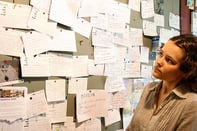Published on
The Promise of Interdisciplinary Education: Blending STEM and Liberal Arts

The following interview is with Joseph Helble, dean of the Thayer School of Engineering at Dartmouth College. In recent years, liberal arts programming has faced increasingly significant critiques of its value for students. Reports into the disparity in earnings between liberal arts degree holders and graduates of STEM (science, technology, engineering and mathematics) programs have added fuel to the fire. In this interview, Helble shares his thoughts on this debate and discusses how liberal arts and engineering programs can be adapted to better meet the needs of present and future graduates.
The EvoLLLution (Evo): What are the most significant advantages of a liberal arts education?
Joseph Helble (JH): If we think about the liberal arts classically, [it] really meant a broad education in a range of subjects in the arts, humanities and social sciences that help us understand and evaluate the world around us.
The liberal arts, when studied broadly and studied well, will help us understand who we are and through that, help give us the ability to think critically, help us develop communication skills — the kinds of things that aren’t just valuable to anyone who wants to consider themselves educated but are very useful skills in the economy and in the marketplace.
Evo: Turning to the critiques, how apt is the criticism facing liberal arts programs as they relate to workforce preparedness?
JH: The challenge with the liberal arts and some of the criticisms is that it’s wonderful in that it teaches critical thinking skills and communication skills and that it provides perspective.
What it doesn’t provide, necessarily, is depth in a particular area or development of a particular skill set that can be put to use by an employer on the job. Training is expensive; it’s very difficult for today’s employers in a very rapidly changing economy and competitive environment to provide on-the-job training to employees who come in without specific skill sets.
While the liberal arts continue to do a wonderful job in teaching critical thinking and these broad skills that we consider not just to be important but essential, they’re often missing quantitative or technology-based content. Often, they’re missing opportunities for students to develop skills in collaboration and in teamwork. Both the ability to work collaboratively as a part of a large multidisciplinary team and the ability to bring specific skills, particularly quantitative and technological skills, to the table to the employer; those are typically missing in the classical liberal arts education and that’s the basis for a lot of contemporary criticism.
Evo: How would you suggest adapting liberal arts programming to better meet the needs of graduates in today’s — and tomorrow’s — labor market?
JH: Often we think about the liberal arts or STEM, the liberal arts or engineering, as what one can study in college in terms of preparing oneself for a job in gainful employment.
It’s really a mistake to think of this as an either/or proposition.
For many years, engineering educators have argued that engineering is enhanced by giving students exposure to the liberal arts. I absolutely think the liberal arts can be enhanced and in some ways made even more relevant by incorporating elements of engineering or technology into a core classic liberal arts education. The liberal arts do a wonderful job of teaching us perspective, giving students or individuals the skills to understand what, when, how and why things happen, how people interact. Engineering and technology provides a wonderful framework for understanding the specifics of how the world functions, for asking why not, for giving people the skills to tackle open-ended problems. In combination it’s really powerful.
Evo: What are the biggest roadblocks standing in the way of this movement from siloed approaches to higher education, which is to some extent where we are now, to a more interdisciplinary system?
JH: The challenge is a classic one. Higher education is siloed, so departments own the curriculum in each department. Developing a curriculum that is sufficiently challenging yet suitable for students who may not be majoring in your particular field is a challenge. While the liberal arts has often had introductory and second-level courses that give an engineering student, for example, more than just basic, superficial exposure to a field but enable you to develop a little bit of breadth and some of the critical thinking skills, engineering hasn’t followed suit. The engineering curriculum, because it’s so highly specialized, tends to exclude students who don’t have the math and science prerequisites that engineering majors need to have to become practicing engineers. There’s a way to bridge that gap by developing basic computer science coding courses, by developing basic project-based design courses that build on some fundamental knowledge in physics, in math and science, but don’t require the advanced prerequisite training that engineering majors need to have.
Breaking down the silos, making introductory engineering classes, project-based classes, more accessible to students studying the liberal arts; that’s a challenge facing engineering educators but it’s one we have control over and one that’s very much worth addressing.
Evo: Is there anything you’d like to add about the evolution not just of liberal arts programming, but also of engineering programming, to a more interdisciplinary model that allows institutions to better serve students on both sides of the STEM divide?
JH: The challenge is in finding ways to make substantive, hands-on connections with technology, exposure to technology and understanding of technology through engineering, through computer science classes accessible to non-engineering majors. That enhances the value of the liberal arts and, frankly, it would make engineering education richer by bringing students to the classroom at the least to the first several introductory classes in engineering who would come at problems from a completely different perspective. Engineering students would benefit from that as well.
This interview has been edited for length.
Author Perspective: Administrator



